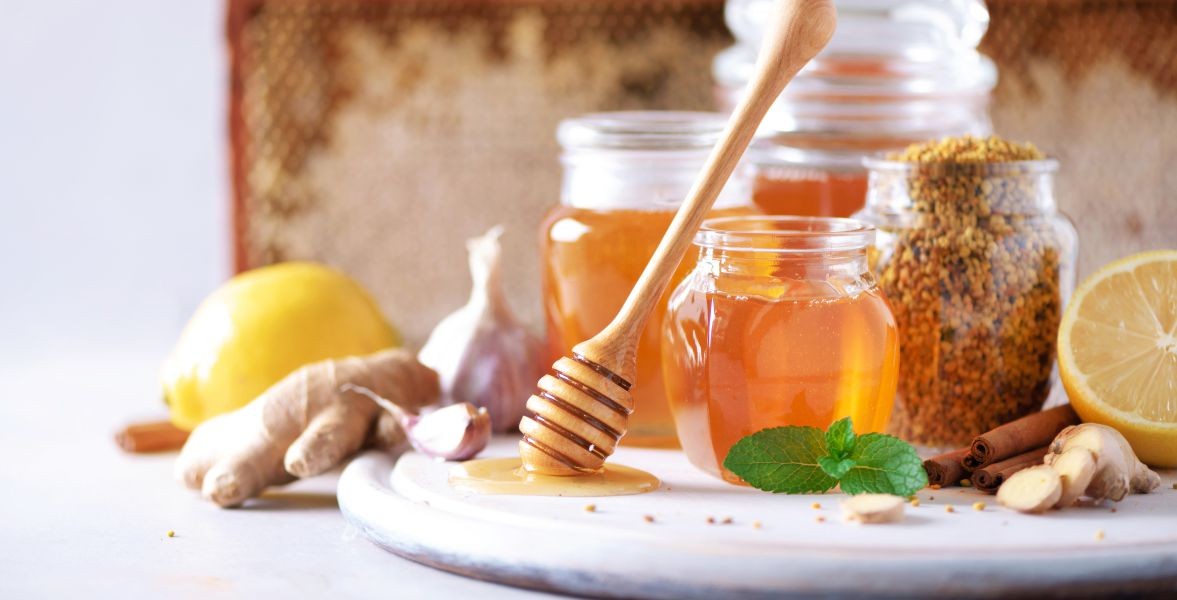Published - Wed, 29 Jun 2022

HOME REMEDIES FOR COLD & COUGH
Coughing, believe it or not, is completely normal. Phlegm and other irritants can be kept out from irritating your throat by coughing. However, a cough can also keep you up all night, make you feel miserable, and at times it may seem as though it will never go away. Here's some encouraging news if you're trying to figure out how to stop coughing: Most coughs go away on their own without needing any medicine. There are several effective natural cough cures available in the meantime. A cough may be relieved by certain natural treatments.
Ginger: Ginger can ease the muscles in the airways. Coughing and other asthmatic symptoms may benefit from this. Anti-inflammatory properties found in ginger may help to lessen throat swelling and inflammation. Additionally, it could ease pain and nausea. Ginger is frequently used in cooking and tea. They should be warned that ginger tea occasionally can cause upset stomachs or heartburn. Slice a fresh ginger root into 1-inch segments to create ginger tea. Depending on how strong you want your tea, boil 1 cup of water for 10 to 15 minutes.
Honey: A well-known treatment for a sore throat is honey. By combining up to two teaspoons of honey with herbal tea or warm water and lemon, you can make your treatment at home. While the lemon juice might relieve congestion, the honey soothes. The two teaspoons of honey can also be consumed straight or combined with a toast to make a spread for a snack.
Hot fluids: Room temperature beverages can help with a runny nose, sneezing, and coughing. However, warming up your beverages may be advantageous for those who are experiencing additional cold or flu symptoms. Even more symptoms, such as a sore throat, chills, and exhaustion, are relieved by hot beverages. After completing the hot beverage, the symptoms continued to be relieved for a while. Clear broths, herbal teas, decaffeinated black tea, warm water, and warm fruit juices are a few hot drinks that may be soothing.
Marshmallow root: The plant marshmallow root has a long history of use as a cough and sore throat remedy. Due to the herb's high mucilage content, coughing-related irritation can be relieved. The mucilage that coats the throat is a thick, glue-like substance. Additionally, dried herbs and tea bags in the form of marshmallow roots are offered. Either drink it right away after adding hot water, or wait until it cools down first. Stomach distress is one of the potential side effects, but this may be managed by consuming more fluids.
Peppermint: It is commonly known that peppermint leaves have therapeutic qualities. The menthol in peppermint can ease throat discomfort and may even make breathing seem more effortless. Both consuming peppermint tea and breathing in the vapors from a steam treatment have advantages. Add seven or eight drops of peppermint essential oil to a cup of freshly boiled water to create a steam treatment. Take a few deep breaths immediately over the water while draping a towel over your head.
Steam: Steam may help a wet cough, which produces mucus or phlegm. Take a hot shower or bath and let the steam fill the room before attempting this technique. Until the symptoms go away, they should spend a few minutes in this steam. After then, they can sip on a glass of water to cool up and avoid being dehydrated. An alternative is to create a steam bowl. To accomplish this, one should:
Pour hot water into a big dish.
Include herbs or essential oils, like rosemary or eucalyptus. These could ease congestion.
Put a cloth over your head and lean over the bowl. The steam is contained in this way, allowing for inhalation.
Continue inhaling the steam for 10 to 15 minutes.
If done once or twice a day, steaming may be beneficial to a person.
Saltwater gargle: A salt and water gargle might help calm a scratchy throat that makes you cough, even though the treatment may appear quite straightforward. To soothe inflammation, combine 1/4 to 1/2 teaspoon of salt with 8 ounces of warm water. Gargling with salt water should be avoided by young children and persons with high blood pressure.
Suck on Lozenges or Hard Candy to Help Stimulate Saliva: Hard candy and lozenges work to boost saliva production or oral secretions, which can reduce coughing. This is a particularly effective treatment for dry cough. Herbal lozenges like those containing zinc, vitamin C, and echinacea may have moderate advantages, even if it's only a placebo effect, and none of them are hazardous, but there aren't much scientific data to support them.
Tulsi: The well-known medicinal plant tulsi offers a variety of advantages. Take a couple of tulsi leaves, crush them, and combine them with honey to soothe your sore throat. Take this mixture three times daily for prompt results.
Turmeric: Over the years, turmeric has been traditionally used for a variety of illnesses, including coughing. Curcumin, the key ingredient in it, has strong anti-inflammatory qualities. Consuming black pepper along with turmeric is advised. That's because piperine, the main ingredient in black pepper, makes turmeric more bioavailable. Warm turmeric tea or golden milk are good options. Add some honey for sweetness and a dash of black pepper.
Created by
Comments (0)
Search
Popular categories
Latest blogs

All you need to know about Syphilis
Tue, 15 Nov 2022

What is Pemphigus Vulgaris?
Tue, 15 Nov 2022

Know about Scorpion Stings
Sat, 12 Nov 2022

Write a public review